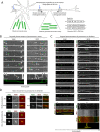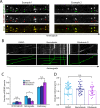Dynein efficiently navigates the dendritic cytoskeleton to drive the retrograde trafficking of BDNF/TrkB signaling endosomes
- PMID: 28720664
- PMCID: PMC5597326
- DOI: 10.1091/mbc.E17-01-0068
Dynein efficiently navigates the dendritic cytoskeleton to drive the retrograde trafficking of BDNF/TrkB signaling endosomes
Abstract
The efficient transport of cargoes within axons and dendrites is critical for neuronal function. Although we have a basic understanding of axonal transport, much less is known about transport in dendrites. We used an optogenetic approach to recruit motor proteins to cargo in real time within axons or dendrites in hippocampal neurons. Kinesin-1, a robust axonal motor, moves cargo less efficiently in dendrites. In contrast, cytoplasmic dynein efficiently navigates both axons and dendrites; in both compartments, dynamic microtubule plus ends enhance dynein-dependent transport. To test the predictions of the optogenetic assay, we examined the contribution of dynein to the motility of an endogenous dendritic cargo and found that dynein inhibition eliminates the retrograde bias of BDNF/TrkB trafficking. However, inhibition of microtubule dynamics has no effect on BDNF/TrkB motility, suggesting that dendritic kinesin motors may cooperate with dynein to drive the transport of signaling endosomes into the soma. Collectively our data highlight compartment-specific differences in kinesin activity that likely reflect specialized tuning for localized cytoskeletal determinants, whereas dynein activity is less compartment specific but is more responsive to changes in microtubule dynamics.
© 2017 Ayloo et al. This article is distributed by The American Society for Cell Biology under license from the author(s). Two months after publication it is available to the public under an Attribution–Noncommercial–Share Alike 3.0 Unported Creative Commons License (http://creativecommons.org/licenses/by-nc-sa/3.0).
Figures







References
MeSH terms
Substances
Grants and funding
LinkOut - more resources
Full Text Sources
Other Literature Sources

